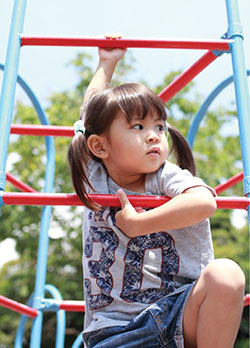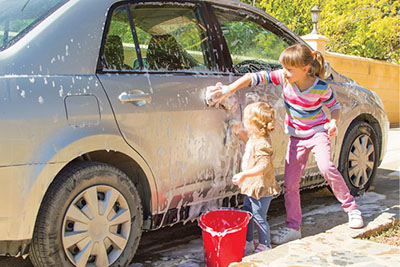Guide I-103
Revised by Lourdes Olivas
College of Agricultural, Consumer and Environmental Sciences, New Mexico State University
Author: Extension Associate, Department of Extension Family and Consumer Sciences, New Mexico State University. (Print Friendly PDF)
It’s a simple fact. Whether you are an adult or an adolescent, physical activity enhances your health, both physically and mentally. Combined with eating well, physical activity is what the body (and mind) needs, and just what the doctor ordered.
Being physically active improves the functioning of the body, affects how much fat versus how much muscle a person has, and contributes to healthy weight management. Increased physical activity has been associated with an increased life expectancy through decreasing risks of diseases such as heart disease, stroke, diabetes, and high blood pressure. Research has also shown that physical activity can reduce symptoms of anxiety, depression, and stress, and improve mood and overall psychological well-being.
Preteen and teen years are crucial for developing a healthy lifestyle. Being inactive during these years increases the probability of being inactive as an adult, whereas forming healthy habits will pay off for years to come.
© Ziggymars | Dreamstime.com
Examples of Moderate Physical Activity
- Light bike riding
- Rollerblading
- Skateboarding
- Walking the dog
- Walking to school
- Golfing
- Playing on a jungle gym
- Flying a kite
- Playing hopscotch
- Playing catch
- Doing active chores
- Shooting baskets
- Tossing a frisbee
Examples of Vigorous Physical Activity
- Fast bike riding
- Playing soccer
- Running
- Jogging
- Dancing
- Jumping rope
- Playing tag
- Aerobics
- Swimming laps
- Fast skating
- Karate
- Playing tennis
Specific Physical Activity Recommendations For Children Ages 3 to 5:
- Preschool-aged children should be physically active throughout the day; a reasonable target is 3 hours per day of all intensities (light, moderate, and vigorous intensity).
- Activities can include running, skipping, hopping, jumping, tumbling, and riding a bicycle or tricycle.
- Overall, encourage preschool-aged children to engage in active play.
Specific Physical Activity Recommendations For Children Ages 6 to 17:
- School-aged children should aim for 60 minutes of moderate to vigorous physical activity each day to achieve the health benefits of being physically active.
- Aerobic activity should be done every day for 60 minutes or more at an intensity of moderate to vigorous. Vigorous-intensity activity should be done at least 3 days a week.
- Muscle-strengthening and bone-strengthening activities should be a part of the 60 minutes or more on at least 3 days a week.
- Vigorous-intensity activities for youth (6–17) are important to incorporate for a greater improvement in cardiorespiratory fitness.
Motivational Considerations
Certain factors will influence whether or not children engage in physical activity and should be considered. For example:
- Is the activity fun for them?
- Have they been taught the necessary skills for the activity so they don’t get discouraged?
- Have they developed confidence in their physical abilities?
- Are they guided and supported by adults in their life regarding physical activity in general and any specific activities they wish to engage in?
- Are they supported by cultural norms (e.g., school, peers, family) that make participation in physical activity desirable?
Various sports, of course, offer avenues for physical activity. However, organized sports are not for everyone. The important thing is to be physically active. That can be walking, wheeling one’s wheel chair, gardening, biking, hiking, running, riding horseback, swimming, or playing soccer—what’s important is being on the move (play) and enjoying it!
© Millennials | Dreamstime.com
How You Can Help Your Kids Be Physically Active:
- Participate in physical activities with your kids.
- Limit screen time (TV, computers, phones, video games) to less than 2 hours per day.
- Plan physical activities for the entire family that everyone can enjoy.
- Provide a safe environment for your child and their friends to play and be active.
- With your child’s interests and skills in mind, choose physical activity-related gifts, such as a tennis racket, a baseball mitt, rollerblades, or a jump rope.
Sources
- American Heart Association
- Gatorade Sports Science Institute
- National Association for Sport and Physical Education (NASPE)
- U.S. Department of Health & Human Services
For Further Reading
I-101: Physical Activity and You (for Adults)
https://pubs.nmsu.edu/_i/I101/
I-104: Teens and Self-cutting (Self-harm): Information for Parents
https://pubs.nmsu.edu/_i/I104/
I-113: Measles: Protecting Yourself and Your Family
https://pubs.nmsu.edu/_i/I113/
Original authors: Bruce Jacobs, former Extension Health Specialist. Subsequently revised by Carol Turner, Extension Food and Nutrition Specialist.
To find more resources for your business, home, or family, visit the College of Agricultural, Consumer and Environmental Sciences on the World Wide Web at pubs.nmsu.edu.
Contents of publications may be freely reproduced, with an appropriate citation, for educational purposes. All other rights reserved. For permission to use publications for other purposes, contact pubs@nmsu.edu or the authors listed on the publication.
New Mexico State University is an equal opportunity/affirmative action employer and educator. NMSU and the U.S. Department of Agriculture cooperating.
Revised September 2019 Las Cruces, NM





